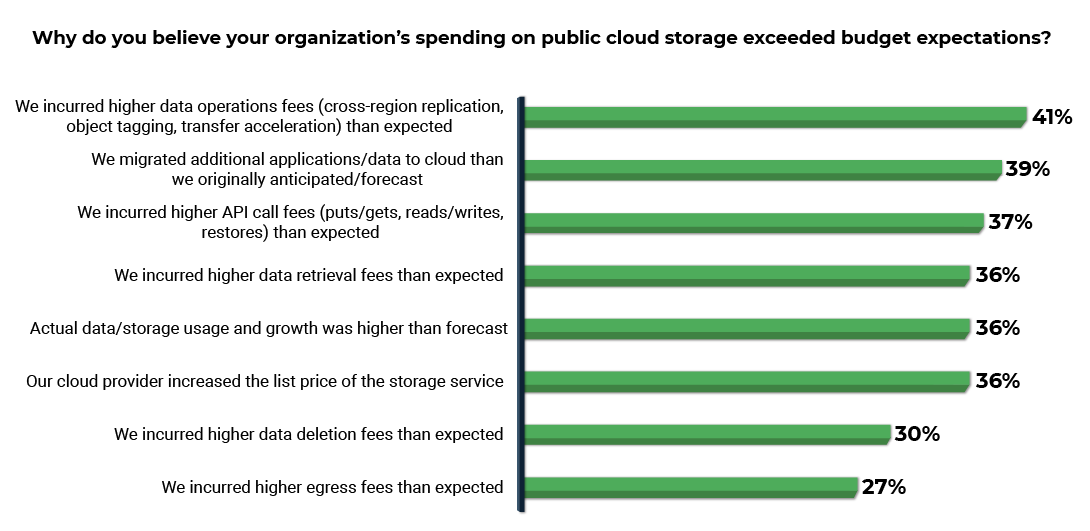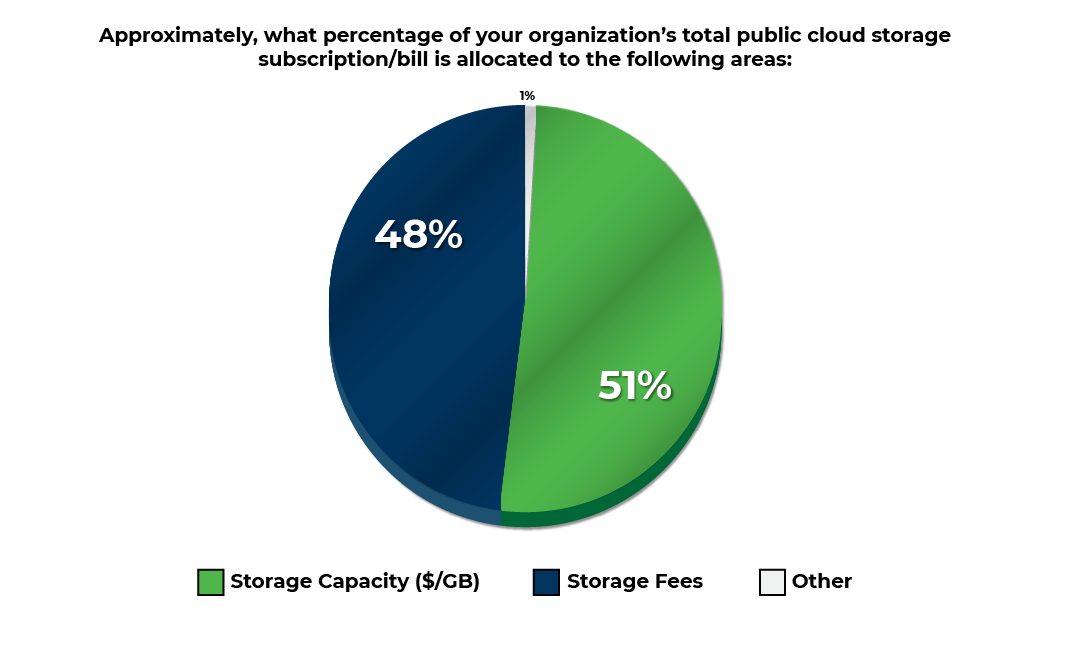BUSINESS
The Public Cloud Infrastructure Industry has a Fee-dependence Problem
The Public Cloud Infrastructure Industry has a Fee-dependence Problem
Wasabi 2023 Global Cloud Storage Index sheds light on cloud storage budgets, billing, and fees
The fee structures associated with public cloud compute and storage services, and the cloud infrastructure services market overall, are well established. These fees include charges for API operations and requests, data movement among locations in the cloud, data movement out of the cloud, as well as a range of optional charges to enhance your service capabilities (e.g., paying an additional fee for expedited retrieval of your data to gain access to it faster than the baseline SLA).
These fee structures have become a de facto standard in the cloud infrastructure industry, allowing major providers to build multi-billion-dollar businesses off this fee-laden billing model. Surely, the enterprise market is aware of this fee structure dynamic, but it has largely (perhaps begrudgingly) acquiesced knowing the overall cost of cloud infrastructure would likely still be lower than their legacy on-premises alternative.
However, there's good reason to believe that the traditional cloud infrastructure billing model is not sustainable over the long term, and sentiment among enterprise buyers is already beginning to change. Opinion on this trend is informed by the Wasabi 2023 Global Cloud Storage Index, an analysis based on 1,000 IT decision-makers worldwide who are involved in their organization’s cloud storage purchase process. The Cloud Storage Index showed us that 52% of organizations exceeded their budgeted spend on cloud storage in 2022. When we dug deeper, we learned that 90% of the respondents who were over budget cited one or more transaction fees as the reason(s) for excess spending. These findings, as well as their potential impact on the cloud storage market, are discussed in more detail below.
1. Egress fees are just the tip of the iceberg
Egress fees, a catchall term used to describe almost any fee associated with data movement or transfer within or out of the public cloud, have long been the scapegoat of the cloud world. However, data from the 2023 Global Cloud Storage Index indicates that egress fees are not a top reason for excess budget spend – in fact egress was ranked at the very bottom of the list:

Although egress fees may be painful, they likely aren’t the main culprit as to why more than half of organizations exceeded their budgeted cloud storage spending in 2022. It is the more mundane, day-to-day data fees from operations, retrievals, and API calls that appear to have a much larger impact on overall billing and the probability of excessive cloud spending. The key takeaway is to remain vigilant of various egress fees but remember that they are likely just the tip of the iceberg when it comes to your overall cloud billing fee structure and how these fees impact your spending.
2. Modern public cloud billing models are unsustainable
The 2023 Global Cloud Storage Index showed that cloud storage bills are almost split evenly between storage-related fees and the cost of actual stored capacity.

This proportion did not change materially when we looked at the data by global region, country, company size, or industry. All segments were within +/- 5% points of the global average. Clearly, the public cloud infrastructure industry has a fee-dependence problem. The real danger is that this dependence on fees is not sustainable over the long term, and ultimately will be a detriment to our industry.
Enterprise sentiment will continue to turn negative when it comes to this fee structure, and the financial uncertainty and risk aversion of 2023 will likely act as an accelerant. Macroeconomic challenges and threats of recession at the end of 2022 forced many enterprises to reevaluate budgets and spending on cloud services. Organizations were emerging from 2+ years of pandemic-related digital infrastructure purchases and cloud adoption initiatives and realizing that their cloud spending was difficult to manage, difficult to predict, and in many ways inefficient. This growth in cloud infrastructure spending and the inherent complexity of mainstream cloud billing models is one of the main reasons for the rise of “FinOps” concepts – the idea that you need an entire financial management discipline and business practice dedicated to monitoring your organization’s cloud spending. This seems ridiculous, but clearly necessary when we look at the high proportion of billings attributed to variable and sometimes unpredictable fees.
Where do we go from here?
We can’t predict the future, but our best equivalent to help understand how the cloud infrastructure market and billing models might evolve over time is to look at the consumer market – where cloud services are increasingly ubiquitous.
In the consumer market, there’s a quiet war being waged against “junk fees” charged by various industries – which often take the form of service fees, cancellation fees, change fees, etc. This effort gained presidential attention in the United States during February’s State of the Union address. And the United States Congress currently has a “Junk Fee Prevention Act” in front of them for consideration. The fact is that in the consumer space, most buyers hate fees. And many of the most popular cloud services have taken advantage of this fact. Netflix is a great example – they charge a monthly subscription which appears as a single line item. Imagine if Netflix charged you a monthly subscription and then added on fees every time you pause, fast forward, or rewind a movie stream. This hypothetical seems crazy, but it is extremely similar to the way that leading vendors have structured their public cloud infrastructure services billing models.
By observing the consumer market, we see a clear trend of consumers pushing back against fee structures, and prioritizing services that offer simplicity of billing. I believe it is safe to assume that this mindset will slowly influence enterprise infrastructure buyers over time. In the end, simplicity is key. Markets often trend towards simplicity over time, whether that simplicity manifests as part of a payment model, deployment model, usage model, or something else. We have no reason to believe the cloud infrastructure-as-a-service market should be any different

Webinar: Key Findings from the 2023 Global Cloud Index
From budgets and billing complexities, to security and compliance, to the challenges of migrating and managing data in a multicloud world, see what your peers are thinking about cloud storage strategies and the critical challenges they face.
Watch Now

the bucket
The fee structures associated with public cloud compute and storage services, and the cloud infrastructure services market overall, are well established. These fees include charges for API operations and requests, data movement among locations in the cloud, data movement out of the cloud, as well as a range of optional charges to enhance your service capabilities (e.g., paying an additional fee for expedited retrieval of your data to gain access to it faster than the baseline SLA).
These fee structures have become a de facto standard in the cloud infrastructure industry, allowing major providers to build multi-billion-dollar businesses off this fee-laden billing model. Surely, the enterprise market is aware of this fee structure dynamic, but it has largely (perhaps begrudgingly) acquiesced knowing the overall cost of cloud infrastructure would likely still be lower than their legacy on-premises alternative.
However, there's good reason to believe that the traditional cloud infrastructure billing model is not sustainable over the long term, and sentiment among enterprise buyers is already beginning to change. Opinion on this trend is informed by the Wasabi 2023 Global Cloud Storage Index, an analysis based on 1,000 IT decision-makers worldwide who are involved in their organization’s cloud storage purchase process. The Cloud Storage Index showed us that 52% of organizations exceeded their budgeted spend on cloud storage in 2022. When we dug deeper, we learned that 90% of the respondents who were over budget cited one or more transaction fees as the reason(s) for excess spending. These findings, as well as their potential impact on the cloud storage market, are discussed in more detail below.
1. Egress fees are just the tip of the iceberg
Egress fees, a catchall term used to describe almost any fee associated with data movement or transfer within or out of the public cloud, have long been the scapegoat of the cloud world. However, data from the 2023 Global Cloud Storage Index indicates that egress fees are not a top reason for excess budget spend – in fact egress was ranked at the very bottom of the list:

Although egress fees may be painful, they likely aren’t the main culprit as to why more than half of organizations exceeded their budgeted cloud storage spending in 2022. It is the more mundane, day-to-day data fees from operations, retrievals, and API calls that appear to have a much larger impact on overall billing and the probability of excessive cloud spending. The key takeaway is to remain vigilant of various egress fees but remember that they are likely just the tip of the iceberg when it comes to your overall cloud billing fee structure and how these fees impact your spending.
2. Modern public cloud billing models are unsustainable
The 2023 Global Cloud Storage Index showed that cloud storage bills are almost split evenly between storage-related fees and the cost of actual stored capacity.

This proportion did not change materially when we looked at the data by global region, country, company size, or industry. All segments were within +/- 5% points of the global average. Clearly, the public cloud infrastructure industry has a fee-dependence problem. The real danger is that this dependence on fees is not sustainable over the long term, and ultimately will be a detriment to our industry.
Enterprise sentiment will continue to turn negative when it comes to this fee structure, and the financial uncertainty and risk aversion of 2023 will likely act as an accelerant. Macroeconomic challenges and threats of recession at the end of 2022 forced many enterprises to reevaluate budgets and spending on cloud services. Organizations were emerging from 2+ years of pandemic-related digital infrastructure purchases and cloud adoption initiatives and realizing that their cloud spending was difficult to manage, difficult to predict, and in many ways inefficient. This growth in cloud infrastructure spending and the inherent complexity of mainstream cloud billing models is one of the main reasons for the rise of “FinOps” concepts – the idea that you need an entire financial management discipline and business practice dedicated to monitoring your organization’s cloud spending. This seems ridiculous, but clearly necessary when we look at the high proportion of billings attributed to variable and sometimes unpredictable fees.
Where do we go from here?
We can’t predict the future, but our best equivalent to help understand how the cloud infrastructure market and billing models might evolve over time is to look at the consumer market – where cloud services are increasingly ubiquitous.
In the consumer market, there’s a quiet war being waged against “junk fees” charged by various industries – which often take the form of service fees, cancellation fees, change fees, etc. This effort gained presidential attention in the United States during February’s State of the Union address. And the United States Congress currently has a “Junk Fee Prevention Act” in front of them for consideration. The fact is that in the consumer space, most buyers hate fees. And many of the most popular cloud services have taken advantage of this fact. Netflix is a great example – they charge a monthly subscription which appears as a single line item. Imagine if Netflix charged you a monthly subscription and then added on fees every time you pause, fast forward, or rewind a movie stream. This hypothetical seems crazy, but it is extremely similar to the way that leading vendors have structured their public cloud infrastructure services billing models.
By observing the consumer market, we see a clear trend of consumers pushing back against fee structures, and prioritizing services that offer simplicity of billing. I believe it is safe to assume that this mindset will slowly influence enterprise infrastructure buyers over time. In the end, simplicity is key. Markets often trend towards simplicity over time, whether that simplicity manifests as part of a payment model, deployment model, usage model, or something else. We have no reason to believe the cloud infrastructure-as-a-service market should be any different

Webinar: Key Findings from the 2023 Global Cloud Index
From budgets and billing complexities, to security and compliance, to the challenges of migrating and managing data in a multicloud world, see what your peers are thinking about cloud storage strategies and the critical challenges they face.
Watch Now
featured articles
WASABI MEDIA & ENTERTAINMENT
April 10, 2024
Introducing Wasabi AiR: Unleash the Power of AI wit...
Introducing Wasabi AiR: Unleash the Power of AI wi...
TECH PARTNERS HEALTHCARE
April 18, 2024
Protect Your Research Data with Cost-friendly, Powe...
Protect Your Research Data with Cost-friendly, Pow...
TECH PARTNERS
April 11, 2024
Addressing AI Infrastructure Challenges with Wasabi...
Addressing AI Infrastructure Challenges with Wasab...
VIDEO SURVEILLANCE
April 9, 2024
Why More Organizations Are Choosing Cloud Storage f...
Why More Organizations Are Choosing Cloud Storage ...
TECH PARTNERS
April 10, 2024





